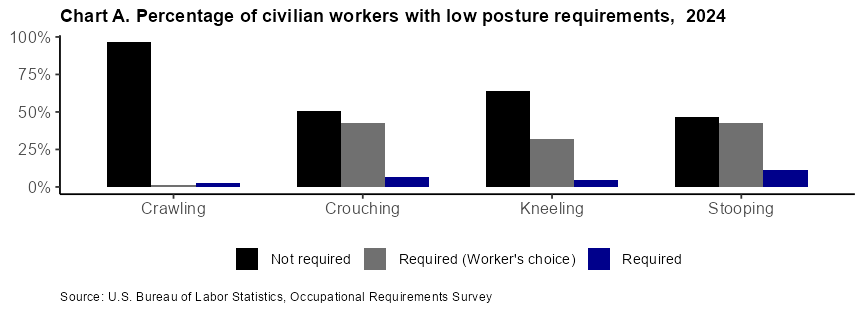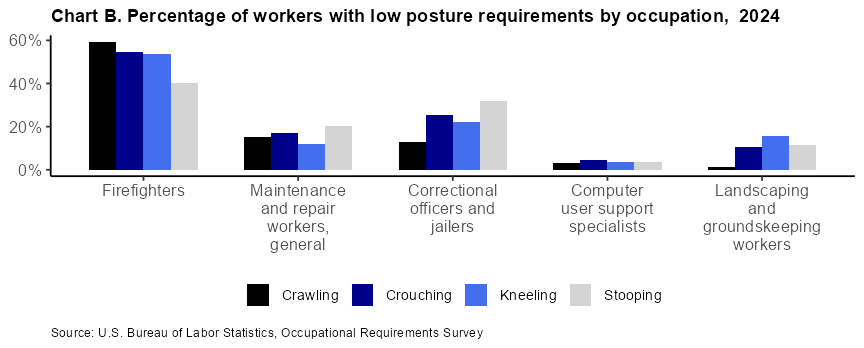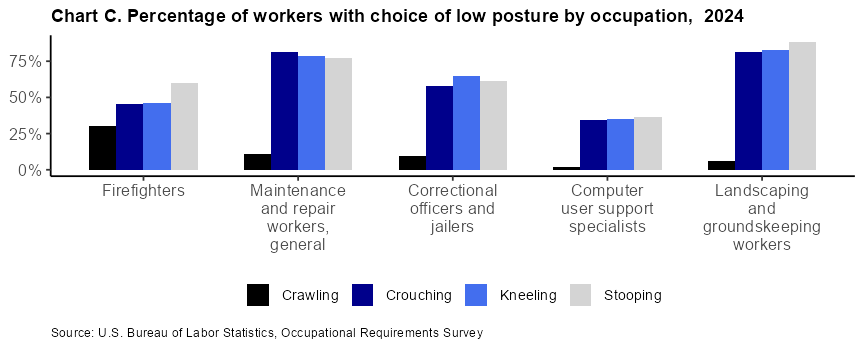An official website of the United States government
 United States Department of Labor
United States Department of Labor
The Occupational Requirements Survey (ORS) publishes job-related information on physical demands; environmental conditions; education, training, and experience; as well as cognitive and mental requirements. The job requirements reflect those necessary for workers to perform critical tasks in support of the critical job functions, and not the capabilities of individual workers. Low postures estimates are considered part of the physical demand for workers in the U.S.
There are four positions included in low postures:
The low posture estimates indicate the percentage of workers with the requirement to perform critical tasks in low postures and are provided as:
Workers may be required to perform some critical tasks in a specific low posture and other critical tasks may allow for choice in low postures.
Low postures were not required for 43.9 percent of civilian workers. There were some occupations where more than 99.5 percent of workers were not required to perform critical tasks in low postures. For example, management analysts, public safety telecommunicators, and lawyers.
While 56.1 percent of civilian workers were required to perform critical tasks in low postures, crouching was required for 6.7 percent of workers. Another 42.8 percent of civilian workers were able to choose whether to crouch to complete critical tasks. (See Chart A.)

Crawling was required for 59.4 percent of firefighters, 54.7 percent were required to crouch, 53.9 percent were required to kneel, and 40.2 percent were required to stoop. (See Chart B.)

Crawling is the only low posture that involves movement, and it is less easily replaced by other low postures. Although crawling is less interchangeable, there may be instances where workers have a choice whether to crawl or perform another posture. For example, electricians may have a choice of whether to crawl while working on low wiring, but they may also stoop, kneel, or crouch if they prefer. Crawling was required for percent of electricians and percent could choose to crawl. (See Chart C.)

Durations of low postures
Low posture duration estimates are also published when possible. However, these measure the duration of low postures and are not available for individual postures (crawling, crouching, kneeling, and stooping).
Duration estimates provide the percentage of workers performing low posture by the portion (or range) within the workday spent performing critical tasks in low postures. For instance, 11.8 percent of light truck drivers were required to perform critical tasks in low postures up to two percent of the workday (seldom) and 84.2 percent were required to perform tasks in low postures occasionally (two percent to 1/3 of the workday).
The sum of these estimates equals the total percentage of light truck drivers with low posture requirements: 96 percent.
Similarly, while 71.5 percent of teaching assistants (preschool, elementary, middle, and secondary school, except special education) were required to perform tasks in low postures, 11.0 percent of these workers performed critical tasks seldom (up to two percent of the workday), 55.8 percent performed critical tasks in low postures occasionally (from two percent up to 1/3 of the workday), and 4.7 percent performed tasks in low postures frequently (from 1/3 up to 2/3 of the workday).
| Occupation | Required | Seldom | Occasionally | Frequently |
|---|---|---|---|---|
|
Light truck drivers |
96.0 | 11.8 | 84.2 | - |
|
Amusement and recreation attendants |
94.4 | 21.4 | 73.0 | - |
|
Cooks, institution and cafeteria |
91.6 | 13.8 | 77.8 | - |
|
Recreation workers |
83.6 | 18.5 | 65.1 | - |
|
Bartenders |
79.6 | 25.9 | 53.7 | - |
|
Special education teachers, elementary school |
79.0 | 25.5 | 53.5 | - |
|
Industrial truck and tractor operators |
77.7 | 19.3 | 58.4 | - |
|
Food servers, nonrestaurant |
72.5 | 21.8 | 50.7 | - |
|
Teaching assistants, preschool, elementary, middle, and secondary school, except special education |
71.5 | 11.0 | 55.8 | 4.7 |
|
Shipping, receiving, and inventory clerks |
64.0 | 13.7 | 50.3 | - |
|
Note: Dashes indicate that estimate was not publishable. Source: U.S. Bureau of Labor Statistics, Occupational Requirements Survey |
||||
Additional resources:
Articles:
Minds at work: what’s required according to the Occupational Requirements Survey (PDF)
A look at teachers’ job requirements, employer costs, and benefits (PDF)
Occupational Requirements Survey: Third wave testing report (PDF)
Occupational Requirements Survey: results from a job observation pilot test
The Occupational Requirements Survey: estimates from preproduction testing
For additional information on occupational requirements see the ORS homepage or download the ORS complete dataset to explore the latest estimates.